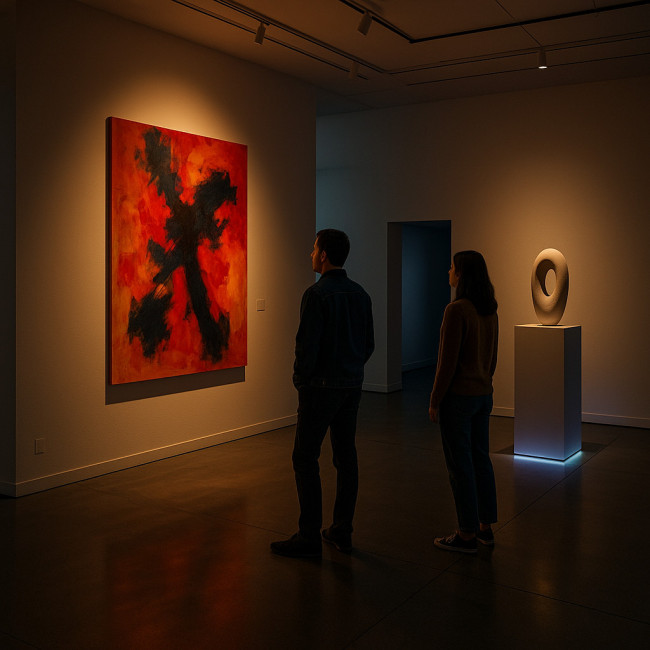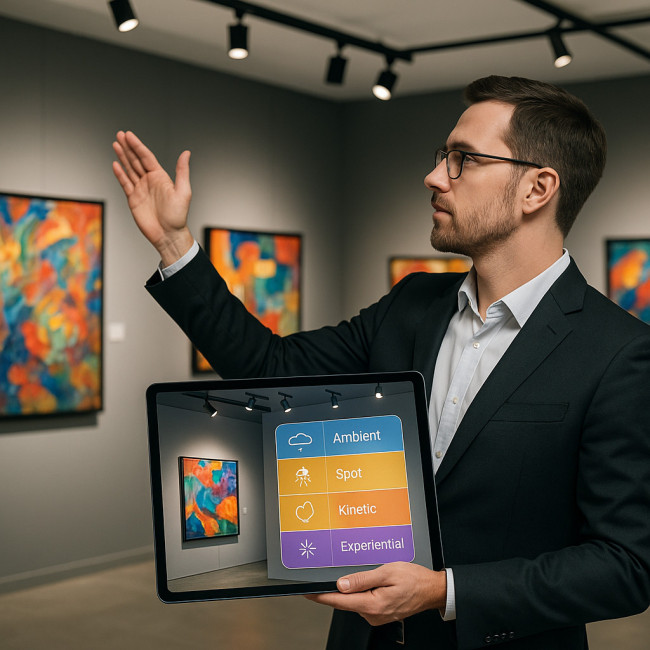Lighting diversity in galleries: why varied ambience wins commercial attention
Uniform lighting may feel safe, yet galleries that layer several ambiences—spot, wash, kinetic and experiential—record longer visitor dwell times, higher artwork sales and more repeat traffic. This guide uncovers the science, metrics and step-by-step tactics to help curators, consultants and visual merchandisers turn luminous variety into measurable revenue.
Why lighting diversity earns more than aesthetic points
1. Human perception favours contrast
Our eyes gravitate toward change. When a space shifts from a cool ambient wash to a warm spotlight, the pupil dilates, cortisol drops and viewers pause—tiny physiological reactions that extend viewing time by up to 18 % in retail-to-art crossover studies (Philips Lighting Retail Lab, 2019).
2. Emotional resonance boosts memory
Multiple ambience zones trigger a richer episodic memory trace. Visitors are more likely to remember an artwork's story—and share it—if the piece was experienced under a distinctive pool of light rather than a uniform grid. Brand storytellers already capitalise on this in window displays; see how experts track footfall data to quantify display impact.
3. Commercial cues become intuitive
Subtle light variations guide foot traffic, highlight premium pieces and nudge purchasing decisions without hard-selling. The technique mirrors best-practice cross-disciplinary lighting partnerships found in hospitality and flagship retail.
Four ambience layers that convert browsers into buyers

The image above distils the layered-lighting theory into a single frame: focal gravity from a narrow spotlight pulls the eye, while the neutral wash cushions peripheral vision and reduces fatigue; meanwhile, slow kinetic ripples create momentary pauses that lengthen dwell time, and discreet RGBW accents weave narrative hues that echo curatorial themes. Notice how each layer serves a distinct psychological function—contrast for attention, comfort for retention, rhythm for engagement, and colour for storytelling—together forming a seamless commercial ecosystem that subtly guides patrons from one highlight to the next and, ultimately, toward purchase-friendly decision points.
Spot lighting: create focal gravity
- Beam angle : 15–25° to sculpt texture and brushwork.
- Luxe touch : CRI ≥ 95 LEDs preserve pigment accuracy.
- Best for : hero pieces, high-price sculptures, limited editions.
Ambient wash: establish visual comfort
- Illuminance : 200–250 lx in circulation zones avoids glare fatigue.
- Colour temperature : 3500 K keeps whites neutral yet inviting.
- Best for : casual browsing zones and label reading areas.
Dynamic or kinetic lighting: trigger micro-pauses
- Technology : DMX-controlled LEDs or projected gobos.
- Rhythm : 10–20 sec animation cycles prevent sensory overload.
- Best for : time-based media, immersive installations.
Experiential accent: evoke narrative
- Sources : fibre optics, concealed light lines, RGBW accents.
- Tonal shifts : align hues with curatorial themes—cool blues for maritime series, sepia warms for historic retrospectives.
- Best for : thematic rooms, pop-up brand collaborations.
Comparative impact of lighting strategies
| Ambience strategy | Average dwell-time uplift* | Average sales uplift* | Documented case study |
|---|---|---|---|
| Uniform 400 lx wash | Baseline | Baseline | — |
| Spot + wash layers | +12 % | +8 % | Philips Lighting Retail Lab, 2019 |
| Spot + dynamic accents | +18 % | +13 % | Samsung LED Museum Pilot, 2020 |
| Full multi-ambience mix | +24 % | +19 % | Museums Association Visitor Study, 2023 |
*Figures reflect median values across three independent studies cited in the table.
Implementation roadmap

Before a single fixture shifts, the roadmap begins with data-driven diagnostics: mapping lux gradients, colour-temperature clusters and energy loads room by room; cross-referencing conservation thresholds for sensitive media; and translating curatorial narratives into programmable scenes. Armed with granular readings, the consultant can stage a phased retrofit—prioritising high-roi focal corridors, leveraging existing tracks to minimise labour, and reserving budget for smart controls that future-proof the investment. This methodical groundwork not only compresses installation timelines but also sets clear benchmarks for post-launch analytics, ensuring every lumen is traceable to visitor behaviour and sales performance.
Step 1 – Audit current infrastructure
Map lux levels, colour temperatures and fixture types. Free mobile apps give a first reading, but a light meter saves guesswork.
Step 2 – Prioritise artwork protection
UV filtration and thermal management matter more once you add high-intensity spots. Consult lighting setups that flatter artwork without damage for maintenance tips.
Step 3 – Layer control protocols
Use DALI or Bluetooth mesh to separate ambience zones. Pre-programmed scenes allow rapid mood shifts for openings, press previews or VIP tours.
Step 4 – Measure ROI early
Pair POS data with visitor-tracking sensors. For digital proof, list new exhibitions in fresh photographer portfolios watched by curators; monitor click-through to correlate online buzz with in-gallery sales.
Step 5 – Communicate the story
Include lighting notes in catalogues and docent scripts. Visual detail boosts perceived value, a principle echoed in visual storytelling tweaks.
Common mistakes that dilute impact
- Over-brightening walls : flattens contrast, negating spot effects.
- Mismatched colour temps : warm spots on cool wash confuse palette perception.
- No maintenance plan : dust and dimming LEDs skew intended ratios within months.
- Ignoring visitor flow : dynamic cues near exits rather than focal works shorten dwell time.
FAQ
- Can diverse lighting harm delicate artworks?
- Not if fixtures include UV filters and emit minimal IR. Keep illuminance under 50 lx for sensitive paper pieces and schedule rotation to limit total exposure.
- How many ambience zones are ideal for a mid-size gallery?
- Three usually suffice: ambient wash, focal spots and one experiential layer. Larger venues may add kinetic accents per room.
- Does dynamic lighting distract buyers?
- Short, subtle cycles (under 20 seconds) attract attention without disrupting contemplation. Avoid rapid colour strobing outside experiential rooms.
- What budget range should I expect for a full upgrade?
- Expect €90–€180 per m², including smart controls. Costs drop when reusing existing track systems and focusing on LED retrofits first.
- How quickly can sales metrics improve?
- Case studies show measurable uplift within the first exhibition cycle—typically eight to twelve weeks—when ambience layers align with curatorial themes.
Quick self-test: can you match lighting to the art?
Take the next luminous step
Ready to upgrade? Draft a phased plan, secure those smart fixtures and let light become your silent salesperson. Need deeper data? Explore how brands analyse footfall to refine lighting ROI and adapt the insights for your gallery.
Turn every lumen into revenue—start layering today.











